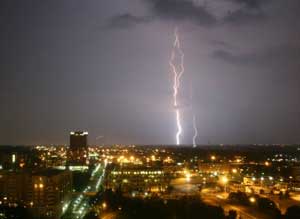Just after the incident of lightning striking and killing four people in Thai Binh Province in early July, experts in thunderstorms at the Institute of Geophysics (Vietnam Academy of Science and Technology) affirmed that human casualties from lightning can be completely avoided with minimal measures.
Lack of Information and Complacency
 |
Dr. Nguyen Xuan Anh – Head of the Atmospheric Physics Department (Institute of Geophysics, Vietnam Academy of Science and Technology) – stated that this year’s thunderstorm season is not unusual, yet the number of people struck by lightning has increased compared to the same period in previous years.
There are three reasons for this. First, the continuous intense heat at the beginning of the season has led to more frequent and stronger thunderstorms. Second, the public lacks information. Most lightning strike fatalities occur in rural areas when people are working in the fields or walking on dikes in remote areas, while the methods of disseminating lightning safety information at the district level only involve flyers, which are outdated.
Third, people remain complacent and lack basic knowledge about lightning safety. It is known that many still seek shelter under tree branches during rain and thunderstorms, despite this being warned against in lightning safety regulations for a long time. “For every 100 people who take shelter under a tree during thunderstorms, 30 are struck and killed by lightning,” Dr. Anh said.
In response to the question: “Why do you assert that this year’s thunderstorm activity is not unusual?”, Dr. Anh explained: “Thunderstorms in Vietnam are very active. Each year has 80–100 days of thunderstorms. The frequency of thunderstorm activity varies significantly from year to year. It is completely normal for this year to have fewer storms and next year to have more compared to the annual average in any locality across the country. Scientists believe that years with higher solar activity will see more thunderstorms.”
Complete Prevention is Possible
During thunderstorms, absolutely avoid taking shelter under trees. If in a remote area without shelter, the best option is to find a flat, dry, or least muddy place to stand. It is advisable not to gather in crowds but to spread out instead.
For rural residents, before heading out to the fields, they should pay attention to thunderstorm forecasts and look for the nearest safe location to run to during a storm.
There are many modern lightning protection devices available now. However, for residential areas, lightning rods are still considered a cost-effective and efficient traditional method.
– What lightning detection devices do we have in our country currently, sir?
– We have a lightning detection system consisting of 8 stations scattered across the country. We are planning to invest 1 million USD to upgrade this system. The goal is to digitize and stream data from the field to the center. As a result, people can view online through the website www.thunderstorm.org.vn where thunderstorms are currently occurring. This information is crucial for the aviation sector, power companies, and residents who currently lack information about thunderstorms.
– Are there any improvements in early thunderstorm warning systems and enhancing warning methods for the public, especially for rural residents?
We are seeking a project from the Ministry of Science and Technology to complete the lightning detection and early warning system in Vietnam. This project originates from research conducted by the Institute of Geophysics since 2002. We have successfully developed early thunderstorm warning devices in Vietnam that are as effective as similar devices worldwide.
These devices have been tested for two years (2001 – 2004) with good results. Once we secure the project, we will implement it broadly in the Mekong Delta (tourist areas, beaches); Hanoi (Phu Thuy, Gia Lam).
Specifically, 1–2 thunderstorm warning stations will be installed in the mentioned localities. These stations will automatically assess thunderstorm activity parameters and will operate according to a specific program based on the characteristics of thunderstorm activity and terrain in each area.
The warning time will be 30-60 minutes, within a radius of 10 – 50 km. Advanced countries can only provide thunderstorm warnings up to 30 minutes in advance.
Vietnam Airlines is planning to place orders with the Institute of Geophysics to install this equipment at airports. We are also ready to cooperate with any locality in need.
– Thank you very much.
|
Lightning Fatalities during the Early Rainy Season of 2006: Around 12 PM on March 26, lightning struck and killed two siblings from the Co Tu ethnic group while they were harvesting rice in their field in A Dinh 2 village (P’Rao Town, Dong Giang, Quang Nam). At around 6 PM on June 9, lightning killed five people in four communes of An Thi District (Hung Yen). The victims included three children and two women who were herding cattle and harvesting rice. Also around this time on the same day, lightning struck and killed a grandmother and her grandchild who were harvesting rice in Trong Chuom field (Yen Ngo village, An Binh, Thuan Thanh, Bac Ninh). Earlier, around 4 PM the same day, lightning struck and killed a tourist named Thuy Van (Vung Tau City). At 7:20 AM on July 1, in the fields of Hong Minh and Minh Hoa communes (Hung Ha, Thai Binh), lightning struck and killed two people and injured five others who were working in the fields. At 7:45 AM on July 2, rain accompanied by thunder struck and killed two people and injured three others in the fields of Van village (Song Lang Commune, Vu Thu, Thai Binh). |


















































